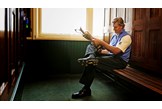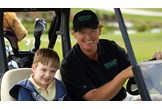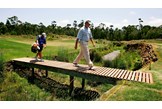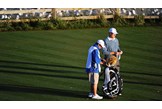Ernie Els: A changed man
Published: Last updated:
Before, during and after both of his Open Championship victories, the most diminutive surname (tied with Ray, Ted) ever inscribed on the famous Claret Jug commanded the same high level of respect from his peers. And in 2012 he looked pretty much as he did a decade earlier. The distinctive, thick blonde locks were still firmly in place. He hadn’t put on too many pounds, not in any of the wrong places anyway, and that famously fluid swing retained almost all of its muchenvied smoothness.
Outward appearances aside, the 42-year-old Ernie Els who rolled in a 20-foot birdie putt on the 18th green to win The Open at Royal Lytham 12 months ago was very different from the 10 years younger version who emerged from an unlikely four-man playoff to topple over the finish line at Muirfield in 2002.
How could he be otherwise? On and off the course, the big South African’s life saw great change between his two triumphs in golf’s oldest and most important championship. First and most impactful, of course, was the diagnosis and announcement in 2008 that Els’ young son, Ben, is autistic.
Then there was the public acknowledgement of his sometimes reckless relationship with alcohol. Next came the slow, inexorable deterioration in his putting, particularly from short range. Throw in a niggling injury or two, a move to Florida from his long-time Wentworth base, a couple of different coaches, the various traumas of 2004 – a season during which he could easily have won at least three majors and ended up with none – and by 2011 he was seemingly a golfer in terminal, albeit understandable, decline.
“The last decade has been very different for me,” confirms Els. “For the first 32 years of my life things went along pretty much the same. But so much has happened in the last 10 years, all of which led to my game falling apart in 2011. I kind of woke up one day and said, ‘If I never have another party, I’m still way ahead of the game’. It’s nice now to just do your thing and get on with it without feeling like hell. Those Monday mornings aren’t as bad. Now I can actually recover and get my body in better shape and ready to go. I’m a little different now.
“Still, I had doubts about my ability to win again. I missed the cut in three majors. I had never done that before. It was worrying. I had no confidence on the greens. You can’t win majors if you can’t putt.”
That was certainly the case for Els. There were a few near things, most notably during that ‘annus horribilis’ in ’04, but for the second-best player of his generation it appeared for long enough that it was going to be ‘three majors and out’ – a poor and unsatisfactory record for one so inherently gifted.
“When I look back at Pebble Beach, I played such wonderful golf from tee to green,” said Els in the wake of another near-miss at the 2010 US Open.
“I really found my swing that week, and I wasn’t even that bad on the greens. It’s just that back nine, it seems like I just kept missing inside eight feet almost on every hole, and I was really, really very disappointed after that. We flew from Pebble to…I think I had to be in Munich the next week, and I was just as flat as I’ve ever been in my life.” To make things worse, Els’ biggest rival over the years was all but writing him off as a serious challenger at the sharpest end of the game. In Tiger Woods’ mind, Ernie had never been quite the same after the boating accident that led to knee surgery in 2005.
“It takes time to come back after that kind of operation,” said Woods, who knows a thing or two about rehabilitation. “Ernie is not a big worker physically and that’s one of the things that you have to do with an ACL repair, you’ve got to really do a lot of work. I feel pretty good with what I’ve done, but I think Ernie could have worked a little bit harder.”
Harsh words indeed, but nothing more than Els was saying to himself. “I wanted to play better,” he confirms. “I didn’t want to be struggling like I was. There’s no worse feeling than to play at a certain level then drop off, knowing you can do a lot better and you’re not there.”
So Els arrived at Lytham almost unnoticed, or ‘under the radar’ in more modern parlance. Few were tipping him to do well, even if his past record on the famous Lancashire links suggested otherwise.
“I could have won two Opens at Lytham if things had gone a bit differently,” Els said at the time. “If I had finished with three pars in 1996, I would have been in a play-off with Tom Lehman. That was a bit of a blow, even if, at the age I was then, I always thought I had time to win more. A year earlier I had a three-shot lead in the US PGA at Riviera and didn’t win. I should have, though. Then when I didn’t win that ’96 Open, the losses started to nag at me a little. Winning the 1997 US Open calmed things down again. But if I had won the ’95 PGA and the ’96 Open I was on my way to a very different, Tiger-like career.
“The ones where you come close and don’t win stay with you. 2004 was easily the worst year of my golfing life. And, at the same time, it was a great year. There were a few ‘almosts’. I almost won all four majors and I was almost No.1 in the world. So, when it comes to majors, I feel like I am maybe a little over par, given the level of my ability and talent. I’m hard on myself, but I feel like five or six wins would be more realistic. That would have put me in the Nick Faldo/Seve Ballesteros sort of area, which is where I feel like I belong.”
While it is hard to argue with that assessment, Els’ perceived ‘failures’ between 2002 and 2012 can at least partly be ascribed to the explosion in technology over the same period. In a world where 18 different players have won the last 19 majors, anything approaching domination has never been more difficult to achieve.
“Equipment advances have had a huge effect on the ability of anyone to separate himself from the rest,” agrees Els. “Everyone is custom-fitted these days. The belly putter helps people like me. The big-headed drivers mean everyone hits it like only Greg Norman used to. You can even get clubs that will help you eliminate draws or fades. Course management is better. And so is fitness. No one is going to big Sunday night parties any more.
“I’m sure the ruling bodies are looking at all those equipment issues. Driving was an art form not so long ago, but it isn’t now. Everyone has a huge metal-headed driver with a huge sweetspot, one that makes bad driving far harder to achieve (laughs). The short game was the same, but it isn’t any more. Everyone can get a club that will help him pitch and chip like only Seve could do in his heyday. I see guys winning now who could never have done so 20 years ago.
Maybe we pros do need to have smaller drivers, less lofted wedges and a ball everyone must use.”
Still, there is one piece of ‘technology’ that has certainly aided Els in his return to something like his old form. He may be honest enough to call it “cheating”, but the so-called ‘belly’ putter has done much to transform his fortunes.
“I can’t deny the belly has been great for me,” says Els with a shrug. “It has been a great apparatus to use in my struggles. But I am certainly not complaining about the ban. It isn’t the way golf is supposed to be played. What it helps me with is the path of the putterhead through and after impact. Especially under pressure – and when you get into your 40s – it gets harder to release the putter through the ball. Whether it is your hands or your mind, something says, ‘Nah’ and you end up steering putts more than stroking them. The belly putter definitely helps me with that.”
It is clear Els is far from done. He will, in fact, return to Muirfield as only the sixth member of the ‘double defender’ club (James Braid at Muirfield in 1906, Walter Hagen at Hoylake in 1930, Henry Cotton at Royal St George’s in 1938, Gary Player at Carnoustie in 1975 and Greg Norman at Turnberry in 1994 are the others). Defending champion of course, he also won the last Open played at the home of the Honourable Company of Edinburgh Golfers.
“He has more majors in him,” maintains veteran South African pro John Bland, who has known Els since he was a teenager. “Tom Watson changed a lot of things at the 2009 Open. No one is walking around thinking someone in his 40s has only a couple of years left any more. Plus, although Ernie has been into a lot of new ventures over the last few years, that is all starting to settle down now. And he has had Ben’s condition to deal with. With his swing and his talent, his career is a long way from over. I can see him playing well until he is close to 50. He will still be long enough. Ernie is like a big bear. If you poke him with a stick he wakes up pretty quickly. He felt that stick over the last few years. And winning at Lytham showed he was ready to stop wandering around.”
One of the most gratifying aspects of the victory at Lytham was Ben being able to see his father win a major. “To do that with Ben watching in London, Liezl telling me he was watching, knowing what was going on…both my kids were so delighted,” says Els. “Samantha is a teenager now, but she can’t remember Muirfield in ’02. So it was really cool to let them know dad is not a bad golfer.
“That said, I’m still exactly the same person I was in ’02. And yet in different ways I’m very different. I wouldn’t say it’s ideal to have autism touch your life, but it is what it is, and we’ve got a great boy in Ben. We’re dealing with it. We’ve found it helps us to really be involved. And we’ve thrown a lot of our weight into our foundation, Els for Autism. We’ve got a lot of work to do, but we’re moving in the right direction, trying to better our lives and other families’ lives.Every week I play, I have at least a dozen people talk to me about autism, how they should deal with it. We talk about similarities between our families.”
Kind of puts putting into perspective doesn’t it?





